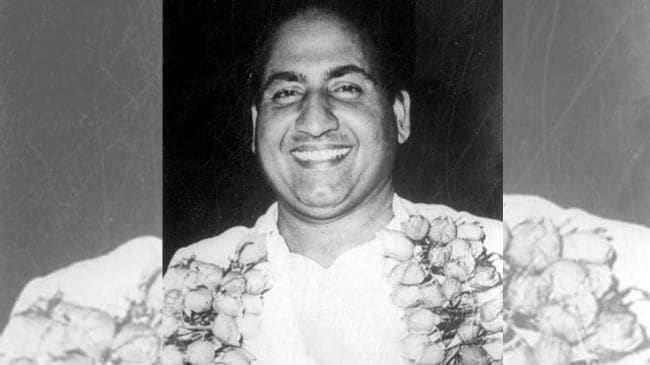Opinion Rafi at 100: Remembering Mohammed Rafi, the man with a silken voice
Rafi, film music’s North Star, whose singing could make the most elementary thoughts and moods reverberate, would have been 100 today.
 Singer Mohammed Rafi. (Express archive photo)
Singer Mohammed Rafi. (Express archive photo) In director Vijay Bhatt’s Baiju Bawra (1952), a musical megahit that stayed in theatre beyond 100 weeks, a contemplative Krishna bhajan sung by Mohammed Rafi swiftly went beyond being a prayer of the faithful. Penned by Shakeel Badayuni and composed by Naushad, Man tadpat hari darshan ko aaj became one of the greatest examples of secular art in a newly independent India that was heard with as much reverence across the border as well.
Backed by a tabla and a sarangi, it also turned around the musical lexicon of the time, one that was steeped in folk music. Naushad had used the midnight glory, raag Maalkauns, in all its splendour. Soon, the somewhat snooty world of classical music spoke in hushed awe about a young film singer, the student of Chhote Ghulam Ali Khan and Ustad Abdul Wahid Khan, who’d presented the most intricate of the microtones with a sphericity and expression not heard in Hindi film music of the time. Rafi, the polite, diligent singer with the silken voice, whose voice could reach the most obscure rims of one’s heart, had arrived.
The film was a fictional story of Baiju — an unknown singer who wants to avenge his father’s death by defeating Tansen in a musical duel. But his guru, Swami Haridas, tells him that a true singer needs to feel pain to be able to find legitimate brilliance. Distraught after his beloved Gauri (Meena Kumari) attempts suicide, Baiju sings, first in a Shiva temple and then on his journey to Agra. The song, O duniya ke rakhwale explored his agony. Rafi’s soulful voice heaves in the delicate Darbari. The legend goes that the taskmaster that Naushad was, he pushed Rafi to the last bit of the taar saptak (highest of the three octaves). So much so that his vocal cords began to bleed and he spit blood and was advised by the doctors to not speak for the next few days, let alone sing. In his career, Rafi ended up singing 149 songs for Naushad, 81 of which were solos.
 Producer HP Goenka, Singer Mohammad Rafi, Talat Mehmood, Indrani Mukherjee and Sahir Ludhianvi at the song recording set of film CHANDI KI DIWAR. (Express archive photo)
Producer HP Goenka, Singer Mohammad Rafi, Talat Mehmood, Indrani Mukherjee and Sahir Ludhianvi at the song recording set of film CHANDI KI DIWAR. (Express archive photo)
Rafi, film music’s North Star, whose silken voice and influence of its expansive range could make the most elementary thoughts and moods reverberate as if full of possibility, would have been 100 today.
Born adjacent to a gurudwara in Kotla Sultan Singh, a tiny village near Amritsar, Rafi, was one of the eight children, born to Allarakhi and Haji Ali Mohammad, who ran a men’s barbershop. Pheeko, as Rafi was called as a child, was moved when he heard a faqeer sing in the street and would imitate his singing. Rafi was about 13 when his family moved to Lahore, where his brother owned a barber shop. His keen interest took him to learn from Chhote Ghulam Ali Khan and Ustad Abdul Wahid Khan. He was 15 and at a concert by KL Saigal, who wasn’t going perform because of the electricity failure. Rafi’s friend Abdul Hameed asked the organisers to let Rafi entertain the guests while the issue was fixed. Rafi sang loudly, without any microphones and dazzled those present including Saigal who blessed him as well as composer Shyam Sundar,who offered him a song in the Punjabi film Gul Baloch (1944). He was invited by AIR Lahore to sing, where he also trained under Jiwan Lal Mattoo, who headed the music section there and was himself an exponent of Kirana gharana.
Rafi moved to Bombay (now Mumbai) in 1944 and rented a tiny apartment in Bhendi Bazaar. His first song was a chorus that he sang for Rs 10 followed by Aji dil ho kaabu mein (Gaon Ki Gori, 1945). Since it was hard to do his riyaz in his tiny room without disturbing the others, Rafi would sit at Marine Drive and sing, not knowing that singer Suraiya’s flat was nearby. When she heard about this, she asked him to practice at her house instead.
 Music director Kalyanji, Mohammad Rafi, Music Director Anandji, Director Prakash Mehra and Producer Indu Bhushan. (Express archive photo)
Music director Kalyanji, Mohammad Rafi, Music Director Anandji, Director Prakash Mehra and Producer Indu Bhushan. (Express archive photo)
While Rafi began working with Naushad around this time, Partition happened but Rafi decided to stay back and decided to move his family as well while Noorjehan with whom he was singing then moved to Pakistan. Baiju Bawra was his big success and earned Naushad a Filmfare Award, his only one.
Thus followed a career where Rafi became a singer who could sing every kind of song. He ruled the patriotic space with Ab tumhare hawale watan saathiyo and Jahan daal daal par sone ki chidiya, could sing with vim and verve the foot-tapping numbers picturised on Shammi Kapoor like those in Junglee and Kashmir Ki Kali, render a complex Madhuban mein radhika with elan and croon a fun Sar jo tera chakraye with the tomfoolery that one didn’t think he had. His duets with Lata Mangeshkar and Asha Bhosle remain some of the most sought after songs in the playback world.
But what the film industry could never stop talking about was Rafi’s generosity, his punctuality, sincerity and the idea of following a composer’s brief like a student of music.When he died at 55 due to a massive heart attack, thousands of mourners attended his funeral despite lashing rains.
In an interview, a journalist once asked Naushad, ‘If you were to create the greatest song of your life today, what would you like’. An emotional Naushad said, “I’d invoke the gods to send back Rafi miyaan (Mohammed Rafi) for one hour”






